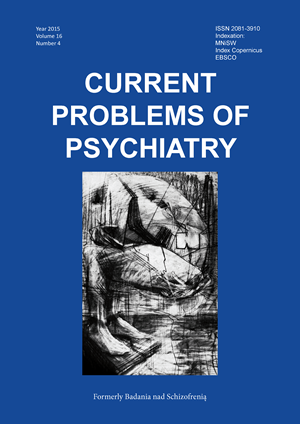Chickpea, Mr. Zdzisław and brain tumor, the story that never happened
Keywords:
mitomania,, Munchausen syndrome, health careAbstract
The case report describes a patient with the diagnosis of harmful alcohol use and, initially, the symptoms of Munchausen syn-drome and later of mitomania. In the 47-year-old patient 3 years before the final psychiatric diagnosis, brain cancer had been supposed-ly diagnosed. The patient described his travel to Czech Republic and neurosurgery operation with gamma knife. Upon return the patient refused to follow doctors’ recommendations. His self-treatment method consisted in making a skin wound in his shin and placing a chickpea inside. With time he started to interlace the facts from his life with the fabricated ones. Some of them, as criminal offences, military service in French Foreign Legion, seemed to be fantastic. Precise examination, the analysis of facts and their verification let us show falseness of the whole story, starting with brain tumor. Besides chronological description of symptoms, the paper describes family, situational and cultural correlations, including wide access to medical knowledge. The theoretical part contributes to classifications of mitomania, its connections with other disturbances and guidelines for differential diagnosis.
References
1. Wald I., Morawski J., Moskalewicz J., Sierosławski J. Wypadki a używanie substancji psychoaktywnych w Europie. Alkoh Narkom, 1991; 7: 5.
2. Schweizer E., Rickels K., Case W.G., Greenblatt D.J. Long-termtherapeutic use of benzodiazepines. II. Effects of gradual ta-per.Arch. Gen. Psychiatry, 1990; 47: 908–915.
3. Liebrenz M, Gehringc MT, Buadze A, Caflisch C High-dose ben-zodiazepine dependence: a qualitative study of patients’ percep-tion on cessation and withdrawal. BMC Psychiatry, 2015; 15: 116
4. Alessi-Severini S, Boulton JM, Enns MW, Dahl M, Collins DM, Chateau D i inni . Use of benzodiazepines and related drugs in Manitoba: a population based study. CMAJ Open. 2014; 2: e208–16.
5. Pollmann AS, Murphy AL, Bergman JC, Gardner DM Deprescribing benzodiazepines and Z drugs in community-dwelling adults: a scoping review. BMC Pharmacol Toxicol. 2015; 16: 19
6. Fang SY, Chen CY, Chang IS, Wu EC, Chang CM, Lin KM. Predictors of the incidence and discontinuation of long-term use of benzodi-azepines: a population-based study. Drug Alcohol Depend. 2009; 104(1–2): 140–6
7. Lader M. Long-term anxiolytic therapy: the issue of drug with-drawal. J Clin. Psychiatr. . 1987;48(Suppl):12–6.
8. de las Cuevas C, Sanz E, de la Fuente J. Benzodiazepines: more" behavioural" addiction than dependence. Psychopharmacology. 2003;167(3):297–303.
9. Ashton H. The diagnosis and management of benzodiazepine dependence. Curr Opin Psychiatry. 2005;18(3):249–55.
10. Petitjean S, Ladewig D, Meier CR, Amrein R, Wiesbeck GA. Benzo-diazepine prescribing to the Swiss adult population: results from a national survey of community pharmacies. Int Clin Psychopharmacol. 2007;22(5):292–8.
11. Basińska-Starzycka A, Jamroży A Bogusław Habrat B. Odstawia-nie benzodiazepin i leczenie zespołów abstynencyjnych u osób uzależnionych. Indywidualizacja postępowania w oparciu o mo-nitoring kliniczny i farmakokinetyczny. Alkoholizm i Narkomania 2009; 22(1): 75-86
12. Szelenberger Waldemar Standardy leczenia bezsenności Polskiego Towarzystwa Badań nad Snem. Sen 2006, Tom 6, Supl. A, A1–A10
13. Reeve E, To J, Hendrix I, Shakib S, Roberts MS, Wiese MD. Patient barriers to and enablers of deprescribing: a systematic review. Drugs Aging. 2013;30:793–807.
14. Cook JM, Biyanova T, Masci C, Coyne JC. Older patient perspec-tives on long-term anxiolytic benzodiazepine use and discontinu-ation: a qualitative study. J Gen Intern Med. 2007; 22:1094–100.
15. Parran T. Jr. Prescription drug abuse. A question of balance.Med. Clin. North Am. 1997; 81: 967–978
16. Svitek J, Heberlein A, Bleich S, Wiltfang J, Kornhuber J, Hillemacher T. Extensive craving in high dose zolpidem depend-ency. Prog Neuropsychopharmacol Biol Psychiatry. 2008; 15;32(2):591-2.
17. Hajak G, Müller WE, Wittchen HU, Pittrow D, Kirch W. Abuse and dependence potential for the non-benzodiazepine hypnotics zolpidem and zopiclone: a review of case reports and epidemio-logical data. Addiction. 2003; 98(10):1371-8.
18. Harris JT, Roache JD, Thornton JE. A role for valproate in the treatment of sedative hypnotic withdrawal and for relapse pre-vention. Alcoh Alcoholism 2000; 35: 319-.323.
19. Ries RK, Roy-Byrne PP, Ward NG, Neppe V, Culisson S. Carbam-azepine treatment for benzodiazepine withdrawal. American Journal of Psychiatry, 1989; 146: 536-537.
20. Schweizer E, Rickels K, Case WG, Greenblatt DJ. Carbamazepine treatment in patients discontinuing long-term benzodiazepine therapy. Effects on withdrawal severity and outcome. Archives of General Psychiatry, 1991; 48: 448-452
21. Wichniak A, Wierzbicka A., Jernajczyk W. Zasady rozpoznawania i leczenia bezsenności. Psychiatr Prakt Klin, 2008; 1(1): 30-39.


